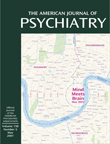To the Editor: We have followed the contributions of Drs. Kessing and Andersen to the understanding of the course of illness in major depressive disorder
(1–
3) and appreciate their interest in our article describing multiple recurrences of major depression. Among the results we reported was the finding that the number of lifetime episodes of major depression was significantly associated with the probability of recurrence, such that the risk of recurrence increases by 16% with each successive recurrence. We certainly agree that the mixed-effects, grouped-time survival analysis model used in our analyses
(4) is best for analyzing data from longitudinal studies, such as NIMH’s Collaborative Depression Study. The model accounts for within-subject variation in risk of recurrence of mood episodes by including multiple well intervals per subject. In contrast, a fixed-effects model can include only one well interval per subject. With the fixed-effects approach, a researcher must arbitrarily select one of many possible well intervals, and the findings are thus vulnerable to the selection phenomenon described by Drs. Kessing and Andersen.
At the recommendation of Drs. Kessing and Andersen, we have reanalyzed our data stratified by sex. We found that the magnitudes of the associations between number of prior mood episodes and risk of subsequent recurrence were nearly identical for men (odds ratio=1.17, 95% confidence interval [CI]=0.87–1.56, p=0.30) and women (odds ratio=1.13, 95% CI=0.97–1.31, p=0.11), which, of course, were similar to the pooled estimate (odds ratio=1.16, 95% CI=1.02–1.31, p=0.02). Nevertheless, because of the reduction in the number of observations and a consequent reduction in statistical power, neither stratified parameter estimate is statistically significant. In contrast, Drs. Kessing and Andersen found an association between number of prior mood episodes and risk of recurrence for women with major depressive disorder but not for men.
There are several possible explanations for the difference between their results and ours. First, the sample sizes and statistical powers vary across studies. In addition, different methods were used in the respective studies. In the NIMH Collaborative Depression Study, subjects are directly interviewed annually, whereas the studies of Dr. Kessing and colleagues
(1–
3) employed a national case register that uses hospitalization as a proxy for recurrence of major depression. As they suggest, we plan to use the mixed-effects, grouped-time survival analysis model to examine the course of illness in subjects with bipolar I disorder.

